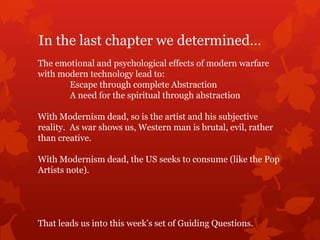
Week 14.postmodernism
- 1. In the last chapter we determined… The emotional and psychological effects of modern warfare with modern technology lead to: Escape through complete Abstraction A need for the spiritual through abstraction With Modernism dead, so is the artist and his subjective reality. As war shows us, Western man is brutal, evil, rather than creative. With Modernism dead, the US seeks to consume (like the Pop Artists note). That leads us into this week’s set of Guiding Questions.
- 2. Guiding Question(s) Who are we? How have we been traditionally defined? With what methods can we question tradition? Definitions of Art Race/Ethnicity Gender Social Problems After generations of taking for granted what we know, the Postmodernists are going to question EVERYTHING.
- 3. Postmodernism Defined PM will delve into the conceptual, art that is based on IDEA rather than an outcome Much of PM work will be unintelligible without a knowledge of the artist’s explored idea PM will assert that identity (gender, race, self, nation) is constructed Our truths are informed by biases and biases (rooted in language) should be deconstructed After the hope of Modernism that says the Artist is God and is creative, PM says that nothing is original After the promises of modernism are dashed, PM will resign that the banal is all we can hope for or trust Emphasis on bodily fluids Emphasis on the ugly
- 4. Guiding Historical Events 1945 Formation of the United Nations Signals the globalization of world economies, but also presents a united front against WORLD problems no longer seen only in nationalistic terms 1966 Formation of National Organization of Women Signals a shift in women’s rights Invention of Reality TV in the 80’s A reminder that we are voyeuers and that we are disconnected
- 5. DECONSTRUCTION—the primary tool of postmodernists Developed by Jacques Derrida Language can mask meaning instead of making it clear Language depends on cultural contexts SO… Deconstruction seeks to “take apart” assumed traditions Makes the hero the anti-hero and the antagonist the hero In literature, we see Kazantzakis’ The Last Temptation of Christ and Lagerkvist’s Barabbas
- 6. Gender is a Construct Male, Female= Sexes (anatomy), Man, Woman= Genders (roles) IDEA--Film culture determines gender roles IDEA--Gender is a disguise we wear, like a set of clothes Cindy Sherman, from the Untitled Film series, 1978
- 7. Race/Ethnicity is a Construct Race=system of classification of humans into groups Ethnicity=cultural aspects (economic, language, social status Reclaims iconography that traditionally stereotypes black women, i.e. the Mammy Here the “slave” takes control of her own life and takes up arms against inequality Betye Saar’s Liberation of Aunt Jemima, 1972
- 8. Jean-Michel Basquiat, Charles the First, 1982 Comments on race and ethnicity— the exploitation of black heroes (Martin Luther, Malcolm X, here Charlie Parker, who dies at the age of 34) Artist identifies with black artists who fall from grace Basquiat overdoses at 27 Transitions between street art and the fine arts Says that mistakes ARE art
- 9. Art is a construct Art no longer belongs to the Elite Art no longer must even be seen by an Audience
- 10. Art is a Construct Art no longer belongs to the Gallery World Anonymous artist working under a tag name Anonymity functional and anti-establishment Graffiti as Street Art Prank as Art Performance Street Art by Banksy
- 11. Christo and Jean-Claude Defy the idea that “art” can be a commodity Environmental Art Ephemeral (not meant to last) Communal (art belongs to everyone) Based on the concept that wrapping objects brings them to our consciousness again To CONCEAL is to reveal To REVEAL is to conceal
- 12. Art is a Construct Art no longer must be seen by an audience In remote, inaccessible location Environmental Art as Ephemeral (changes as nature, not the artist, determines) Robert Smithson’s Spiral Jetty, in the Great Salt Lake of Utah
- 13. The Self is a Construct A series of constructs we simulate (act out), usually unconsciously Self as Bias A set of assumptions Gender we make about ourselves and others Sexual Orientation based on our own experiences Social Class Ethnicity Neither good nor bad; it’s what we do with Nationality them. Religious Belief Leads to “Political correctness” debacle
- 14. Andres Serrano’s Piss Christ If we really want to know ourselves, we have to confront our biases through the banal. To know Christ is to confront his humanity, and ours. Urine is considered dirty by Western society, BUT In fact, it is quite sterile out of the body, and Urination is required to live. Which means Christ had to urinate. What initially seems profane is in fact the artist’s efforts to SHOCK us into questioning our biases
- 15. In subsequent presentations, you will learn more about: The role of the National Endowment for the Arts in contemporary commissions Feminist Art Conceptual Art with components of Performance Art
Notes de l'éditeur
- In answering the guiding questions, we are going to work in the method of a French writer, Jacques Derrida.